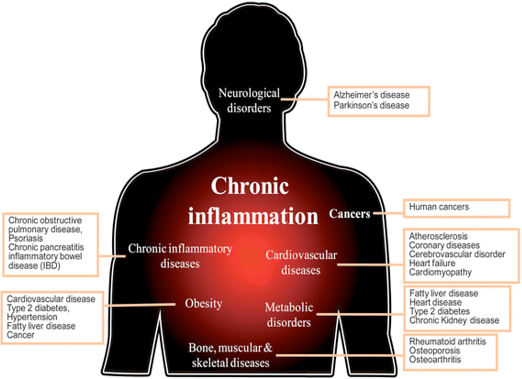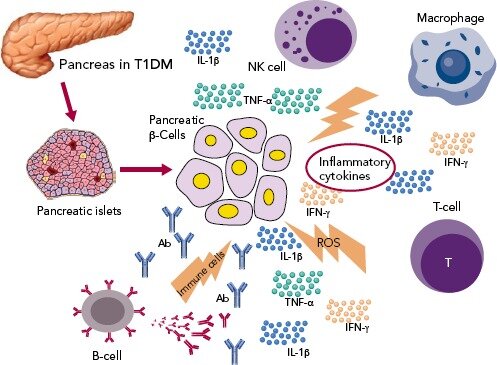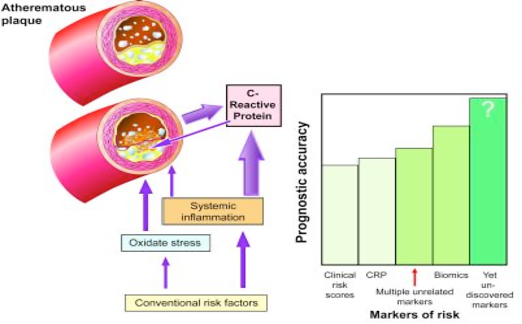There are different forms of inflammation and they can affect people’s bodies in various ways. Whenever I heard the word “inflammation” growing up, I would automatically associate it with swelling from an injury. In a 2020 Harvard article on inflammation, Harvard Health described the difference between acute and chronic inflammation:
“People are most familiar with acute inflammation. This is the redness, warmth, swelling, and pain around tissues and joints that occurs in response to an injury, like when you cut yourself. When the body is injured, your immune system releases white blood cells to surround and protect the area…In contrast, when inflammation gets turned up too high and lingers for a long time, and the immune system continues to pump out white blood cells and chemical messengers that prolong the process, that’s known as chronic inflammation.”
Chronic Inflammation – Root Cause of Almost Every Disease
According to the CDC, the leading causes of death in the United States are the following (in order): heart disease, cancer, accidents (unintentional injuries), chronic lower respiratory diseases, stroke, Alzheimer’s disease, diabetes, nephritis, influenza/pneumonia, and suicide. Chronic inflammation is linked to nearly every single one of these. There’s even a case to be made that inflammation of the blood-brain barrier can lead to acts of suicide or negligent accidents. In any case, it’s plausible to see that the data is strongly suggesting that inflammation could be the root of all physical suffering. Sound like a stretch? Hear me out.

The American Heart Association describes the relationship between heart disease and inflammation as still a topic that deserves much research, but they did admit that “inflammation is common for heart disease and stroke patients and is thought to be a sign or atherogenic response”. Meanwhile, the National Cancer Institute believes that chronic inflammation “may be caused by infections that don’t go away, abnormal immune reactions to normal tissues, or conditions such as obesity. Over time, chronic inflammation can cause DNA damage and lead to cancer. For example, people with chronic inflammatory bowel diseases, such as ulcerative colitis and Crohn’s disease, have an increased risk of colon cancer.”
Source: Cardiac Health
The European Cardiology Review explains that an inflammatory state is brought on “via production of pro-inflammatory cytokines, which is further amplified by adipokines”. Adipokines have been proven to stimulate additional inflammatory responses in obesity and further promote obesity-induced metabolic and cardiovascular diseases.
As for chronic respiratory disease, there is non-refutable evidence that inflammation has plagued those suffering from weakened respiratory systems. In a 2018 Pubmed paper, researchers gathered that “persistent inflammation within the respiratory tract underlies the pathogenesis of numerous chronic pulmonary diseases including chronic obstructive pulmonary disease, asthma, and pulmonary fibrosis”. While chronic inflammation of the lung could arise from a multitude of lifestyle and environmental factors, there is no denying that it is most often the root cause of such challenging health impairments.
Additionally, the European Cardiology Review has claimed that “inflammation has a key role in the pathophysiology of type 2 diabetes and its associated metabolic abnormalities” (see figure below).

Source: European Cardiology Review
Pneumonia and influenza are also very common pathways to death that are deeply associated with chronic inflammation. In a study by the Pulmonary Center at the Boston University School of Medicine, writer Joseph P. Mizgerd ScD made several findings in regards to the relationship between inflammation and such viruses. Such findings “suggest that avoiding inflammatory triggering is a virulence property for pneumococcus, supporting the concept that the degree to which inflammation is rapidly and effectively triggered in the lungs is one important determinant of whether pneumonia results from a lower respiratory infection”.

The way that chronic inflammation can affect one’s health is profound; this is a problem that often first takes hold in the arteries. Cardiac Health detailed this by breaking down how “chronic inflammation of the artery walls leads to plaques becoming more vulnerable to rupturing. This same process can occur within an artery leading to the brain resulting in a stroke. Another common occurrence in advanced disease is the insufficient blood supply to the legs. This is called peripheral artery disease or PAD.”
Source: Cardiac Health
Effects of Inflammation on the Gut & Brain
In Ben Greenfield’s book, Boundless, he details the research of Dr. Datis Kharrazian who dove deep into chronic disease and nutrition. Dr. Kharrazian singles out that inflammatory cytokines, or “molecules that promote inflammation – start in an inflamed gut and can enter the bloodstream, make their way to the brain, and pass through even a healthy blood-brain barrier”. Once these cytokines enter the brain, they can affect sensitive tissues such as the vagus nerve and our autonomic nervous system. Considering the massive role that these systems play in our body, their poor function only allows for more inflammatory cytokines to make their way into the blood in a continual inflammatory cycle.
Dr. Kharrazian has also pointed out that “chronic inflammation impairs the ability of your overall immune system to respond appropriately to pathogens such as viruses”, thus negatively impacting our immune resilience when challenged with viral exposure. This is why removing any common source of food allergies/sensitivities that trigger your inflammatory response is vital. A solid place to start finding out how your diet is altering your gut inflammatory levels is to engage in a stool collected, comprehensive gut test.
During his podcast with Dr. Andrew Hill, Greenfield also spoke about the effects of inflammation on COVID patients.
“Yeah, I got COVID…I’ve realized this isn’t the same for everybody. There are people who are metabolically compromised, people with a high level of inflammation, people who are obese, which is basically the definition of having a high level of inflammation, older people with a higher free radical load, people who might be vitamin D deficient, et cetera. And so, I realized this isn’t the case for everybody, but for me and my wife, it was kind of a joke.”
I agree with the assertion that viruses like COVID-19 impact each individual uniquely, much like the flu and common cold do. Having experienced COVID-19 myself, I can attest that managing the symptoms would have been considerably more challenging with an inflamed respiratory system. When our arteries are inflamed and our body is fighting a virus, breathing becomes significantly more difficult. This inflammation also affects our digestive processes and our brain’s ability to utilize the nutrients from our food. Essentially, inflammation can severely exacerbate any existing vulnerabilities in our bodies if we don’t take steps to prevent it.
Ways to Live An Anti-Inflammatory Lifestyle
There are several methods to decrease inflammation and live an anti-inflammatory lifestyle that I will write a separate article about at a later date, but for now, I will start by sharing my five favorite anti-inflammation hacks.
Cold Exposure
One of my favorite anti-inflammatory hacks is cold exposure. It can be quite challenging, but the positive effects are profound. There are countless studies that prove that exposing yourself to cool temperatures through the form of cold showers, ice baths, or “polar plunges” in bodies of water can “induce an anti-inflammatory response in mesenteric adipose tissue associated with catecholamine production and thermogenin expression”, according to the Endocrine Regulations.
Anti-Inflammatory Foods
Anti-inflammatory foods, such as turmeric, cordyceps, and zinc, are a must-have for all human beings, in my humble opinion. More often than not, we are engaged in the reversal of damage that we negligently caused throughout our lives, thus we must go on the offense by implementing powerful herbs and minerals into our diet immediately. Preventative healthcare is much cheaper than treating a disease.
Quality Sleep
Sleep profoundly impacts the inflammatory response of our cells. Ensuring that we get an adequate amount of uninterrupted, deep sleep on a regular basis will adequately equip us with another tool in fighting the inflammatory cytokine production cycle. Our circadian rhythm is one of the most neglected, underappreciated aspects of our overall health.
Ground Thyself
As we are all exposed to more and more radiation from smart devices each year, we must not neglect the inner hippie within us that wants to walk around barefoot in the dirt. Seriously though, grounding yourself through barefoot walking is not only one of the best ways to rid your body of EMF (electromagnetic field) exposure, but it also increases circulation and reduces inflammation in your body quite effectively. I try to get as much barefoot walking in as I can, without stepping on a nail or getting too much unwanted attention from strangers. One of my favorite ground tools is the EarthRunner sandal, which has a unique and well-designed lacing structure on a very thin sole for optimal freedom. At the bottom of the sole connected to the laces is a copper plug, which electrically grounds the user while hiking. I don’t care how dorky I look in these, I feel great wearing them.
Avoid The Bad Stuff
While factors such as eating the healthiest foods, engaging in cold therapy, and grounding are very important to one’s overall health and well-being, so is cutting out harmful lifestyle choices. If you are doing all the right things, but also eating the four white devils (white sugar, white flour, white salt, and white processed, refined oil), then you need to reevaluate your degree of dietary responsibility.
Conclusion
Chronic inflammation is far too often brushed under the rug as a leading cause of deadly disease. Most of society lives an extremely high-inflammatory lifestyle. However, with the right tweaks and balances, people can begin to regain their vitality and diminish the aging effects that inflammation has on our cellular structure. Follow my anti-inflammatory advice and do your own research on what I have shared if you are interested in boosting your well-being.












